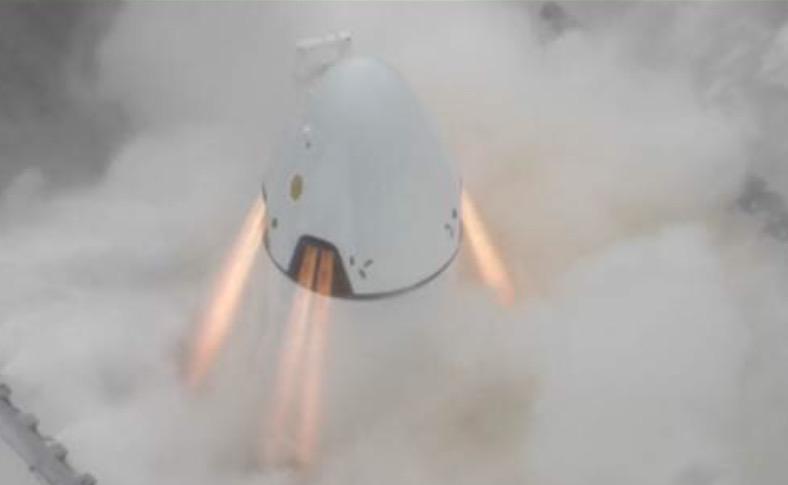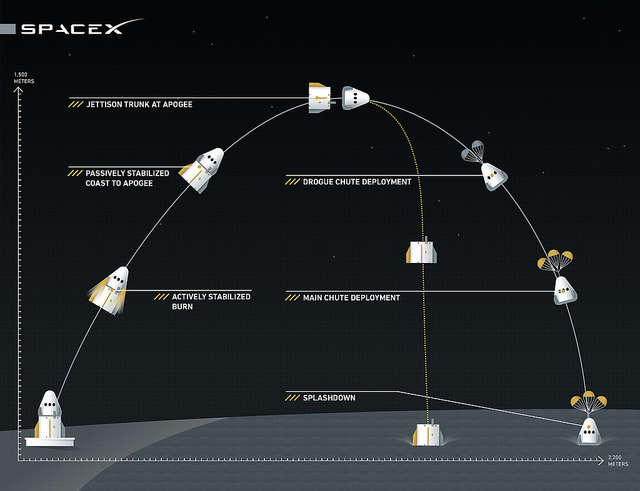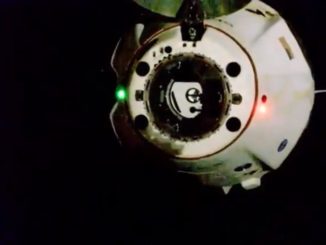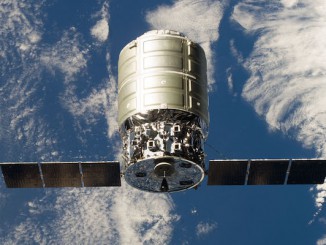SpaceX plans to launch an unmanned test model of the company’s Dragon crew capsule Wednesday on a whirlwind 107-second flight through the skies over Cape Canaveral.
The 8-ton prototype spaceship will only reach a mile an altitude, but the trial aims to verify the Dragon capsule can safely escape from a launch failure and save its occupants from a potentially explosive mishap.
SpaceX says the human-rated spacecraft, which it calls Crew Dragon, will be ready to haul astronauts to the International Space Station in 2017, and Wednesday’s test of the capsule’s abort mechanism is key to proving the ship is safe enough for people.
Founded in 2002 by Elon Musk, the Hawthorne, California-based company has changed the landscape of the commercial launch industry with its Falcon 9 rocket. SpaceX now has its sights set on becoming a major U.S. military contractor and a fixture in human spaceflight.
NASA contracted with SpaceX and Boeing last year to develop commercial spaceships to carry astronauts to the space station and end U.S. reliance on Russia for crew transport services.
Eight hotrod 3D-printed SuperDraco rocket thrusters mounted around the circumference of the capsule are set to fire at 9 a.m. EDT (1300 GMT) to push the 20-foot-tall spacecraft off SpaceX’s launch pad at Cape Canaveral. Officials will watch for gusty winds that could delay the flight, but forecasters predicted Tuesday a 70 percent chance conditions will be acceptable Wednesday.
SpaceX had targeted 7 a.m. EDT (1100 GMT) for the opening of Wednesday’s test window, but a NASA spokesperson said late Tuesday the flight would be delayed at least two hours. Officials did not give a reason for the time change.
Officials said the test window extends until 4 p.m. EDT (2000 GMT), and SpaceX has reserved a backup day Thursday if needed.
Burning a nearly two-ton supply of hydrazine and nitrogen tetroxide propellants, the SuperDraco thrusters will almost instantly ramp up to 120,000 pounds of thrust, propelling the Dragon spaceship to an altitude of 100 meters — 328 feet — in two seconds. By the time the SuperDracos finish firing, the capsule will be a third of a mile above the launch pad.
Put another way, the capsule will go from 0 to nearly 100 mph in one second.

Six seconds of propulsion from the SuperDraco engines will send the spacecraft on an arcing trajectory east from the launch pad toward the beach.
“By the end of the burn — at the end of the six seconds — you’re going between 150 to 180 meters per second (335 to 402 mph),” said Hans Koenigsmann, SpaceX’s vice president of mission assurance. “You’re going pretty fast for the fact that you only stepped on the gas for six seconds.
“That’s faster than a Tesla,” Koenigsmann joked.
Tesla Motors is Musk’s other high-profile company, building electric cars and power systems. The Tesla Model S, featuring an “insane mode” made famous with viral videos, can go from 0 to 60 mph in 3.4 seconds.
“When it takes off, it will pitch slightly over to the east towards the ocean,” Koenigsmann told reporters last week. “It will burn short … It will be over by the time you hear it.”
A crash test dummy fastened in the Dragon’s crew cabin will experience nearly 5 G’s at takeoff, and SpaceX engineers installed sensors all over the vehicle to measure acceleration, structural loads, temperatures, acoustics and the environment inside the capsule.
The Dragon will take approximately 21 seconds to reach the apex of its trajectory at an altitude of nearly 5,000 feet. The craft will let go of a disposable trunk section at peak altitude and rotate to point its heat shield toward the ground.
Then the capsule will deploy a pair of stabilizing drogue parachutes before unfurling three main parachutes for the final descent. Splashdown in the Atlantic Ocean is targeted for a point 1.4 miles from the flight’s starting point 107 seconds after blastoff.

SpaceX posted a timeline of the pad abort flight sequence on the company’s website:
- T-0: The eight SuperDracos ignite simultaneously and reach maximum thrust, propelling the spacecraft off the pad.
- T+.5s: After half a second of vertical flight, Crew Dragon pitches toward the ocean and continues its controlled burn. The SuperDraco engines throttle to control the trajectory based on real-time measurements from the vehicle’s sensors.
- T+5s: The abort burn is terminated once all propellant is consumed and Dragon coasts for just over 15 seconds to its highest point about 1500 meters (.93 mi) above the launch pad.
- T+21s: The trunk is jettisoned and the spacecraft begins a slow rotation with its heat shield pointed toward the ground again.
- T+25s: Small parachutes, called drogues, are deployed first during a 4-6 second window following trunk separation.
- T+35s: Once the drogue parachutes stabilize the vehicle, three main parachutes deploy and further slow the spacecraft before splashdown.
- T+107s: Dragon splashes down in the Atlantic Ocean about 2200 meters (1.4 mi) downrange of the launch pad.
“It doesn’t last long,” said Garrett Reisman, a former astronaut and current director of crew operations at SpaceX. “The boost phase is only a few seconds, and it’s pulling almost 5 G’s when it’s coming off the pad, so it’s going to get out of here in a hurry. My advice to you, if you go outside to watch it, is don’t blink.”
Wednesday’s test flight will demonstrate a safety feature of SpaceX’s Crew Dragon spacecraft designed to drastically improve the odds of survival in the event of a catastrophic launch failure with the capsule’s Falcon 9 booster.
“We’re proud to have a launch escape system in case the Falcon 9 is having a bad day, the Dragon crew can get to safety,” Reisman said. “It’s a capability we had on Gemini and Apollo, and we have it on the Soyuz, but we did not enjoy that on the shuttle. We’re bringing that back to try and make sure our crews are super safe.”
The pad abort test is the first of two demonstrations planned by SpaceX this year.
Once SpaceX ground crews recover the capsule from the Atlantic Ocean, they will transport the craft to the company’s Central Texas test facility for inspections and refurbishment, then outfit the Dragon for an “in-flight” abort test later this year at Vandenberg Air Force Base in California.
The pair of abort tests will verify that the escape rockets can save astronauts at any point during launch, Reisman said.
“There are two points in the trajectory that are the hardest for that system to work,” Reisman said. “The first is when it’s sitting still on the pad, and we call that a pad abort. When you have zero altitude and zero airspeed, you’ve got to get high enough and far enough downrange so you can get the parachutes out, get to the water, and get far enough away from any bad thing that might be happening (on the pad). That proves that you have enough gas in the tank, essentially.”
The in-flight escape test later this year will use a Falcon 9 rocket to boost the capsule to high altitude and trigger an abort under intense aerodynamic forces.
“That proves you have enough thrust in the engines to get away and enough controllability in the guidance navigation and control system to get away in a stable manner, even at the most challenging point,” Reisman said. “We’re going to stick the same test article on top of a Falcon 9 and launch it, and when we get to that point of maximum aerodynamic pressure, we’re going to punch out and make sure she can get away then. When we test those two corner cases, we’re confident it’s going to be OK throughout the entire trajectory.”
Email the author.
Follow Stephen Clark on Twitter: @StephenClark1.



